Chapter 14: Outlining
This chapter is adapted from Stand up, Speak out: The Practice and Ethics of Public Speaking, CC BY-NC-SA 4.0.
Why is outlining important for a speech?

Why Outlining Is Important for a Speech
For your presented speech to be as effective as possible, organize your information into logical patterns that your audience can understand. This especially applies if you already know much about your topic. Take careful steps to include pertinent information that your audience might not know and to explain relationships that might not be evident to them. Using a standard outline format helps you to make decisions about your main points, about choosing information to support those points, and about crafting the appropriate language to use. Without an outline, your message is liable to lose logical integrity. It might even deteriorate into a bullet-point list with no apparent cohesiveness,—except for the topic—leaving your audience relieved when your speech is finally over.
In this chapter, we discuss three outline types: a working outline, a full-sentence outline, and a speaking outline. For working outlines and full-sentence outlines, write in complete sentences; for speaking outlines, write in phrases We’ll give detailed outline examples later in the chapter, but for this first section, we’ll discuss general outlining principles.
An Outline Tests Your Specific Purpose’s Clarity
A full-sentence outline lays a strong foundation. It compels you to have one clear and specific purpose and helps to frame a clear, concrete thesis statement. An outline helps you to exclude irrelevant information that does not directly focus on your thesis, and it reduces the research you must do because you will clearly identify the supporting evidence you need. And when presenting, an outline helps you remember your speech’s central message.
Also, a solid full-sentence outline helps your audience understand and remember your message because they will be able to follow your reasoning. Creating an outline is a task too often perceived as busywork, unnecessary, time consuming, and restrictive. However, students who carefully write a full-sentence outline characteristically give powerful presentations with excellent messages.
An Outline Tests Your Content’s Scope
A clear, concrete thesis statement acts as your outline’s compass. Explicate each main point, then, test your content’s scope by comparing each main point to the thesis statement. If you find a poor match, you will know you’ve wandered outside your thesis statement’s scope, as you will see in the example below.
Specific Purpose: To inform property owners about the economics of wind farms generating electrical energy.
- Your first main point: modern windmills require a very small land base, making real estate cost’s low. This is directly related to the economics thesis. Now, supply information to support your claim that only a small land base is needed.
- Your second main point: you might be tempted to claim that windmills don’t pollute in the ways other sources do. However, you will quickly note that this claim is unrelated to the economics thesis, so stay within this scope. A better second main point: once windmills are in place, they require virtually no maintenance. This claim is related to the economics thesis. Now, supply information to support this claim.
- Your third point: windmill-generated electrical energy is more profitable compared to other sources—many audience members will want to know this. This point is clearly related to the economics thesis, and you will easily find information from authoritative sources to support this claim.
When you write in outline form, it is much easier to test your content’s scope because you can visually locate specific information very easily and then check it against your thesis statement.
An Outline Tests Your Main Points’ Logical Patterns
You have many topic choices, therefore, there are many ways to logically organize your content. In the example above, we simply list three main points that are important economics to consider about wind farms. You can also arrange a speech’s main points into a logical pattern. We discuss these patterns in the Organizing the Speech Body section. Whatever logical pattern you use, if you examine your thesis statement and then look at your outline’s three main points, you will see the logical way in which they relate.
An Outline Tests Your Supporting Ideas’ Relevance
When you create an outline, you clearly see that you need supporting evidence for each main point. For instance, your first main point claims that windmills require less land than other utilities. Therefore, provide supporting evidence about the acreage windmills require and the acreage other energy-generating sites require, such as nuclear power plants or hydroelectric generators. Use expert sources in economics, economic development, or engineering to support your claims. You can even include an expert’s opinion, but not an ordinary person’s opinion. The expert opinion provides stronger support for your point.
Similarly, the second point claims that once a windmill is in place, there is virtually no maintenance cost. To support this claim, provide annual windmill-maintenance costs and compare these to the alternative energy-generating sites’ annual maintenance costs. If you compare nuclear power plants to support your first main point, compare nuclear power plants again to be consistent. It becomes very clear, then, that the third main point about windmill-generated energy’s profitability needs authoritative references to compare it to nuclear power-generated energy’s profitability. In this third main point, use just a few well-selected statistics from authoritative sources to support you claims, and compare them to the other energy sources you’ve cited.
An Outline Tests Your Speech’s Balance and Proportion
Writing a full-sentence outline is visually valuable. You immediately see whether each main point’s importance is approximately equal. Does each main point have the same number of supporting points? If you find that your first main point has eight supporting points while the others only have three each, you have two choices: either choose the best three from the eight supporting points or strengthen the authoritative support for your other two main points. Remember, use the best supporting evidence you can find even if it means conducting more research.
An Outline Serves as Your Speaking Notes
In addition to writing a full-sentence outline to prepare your speech, create a shortened outline to use as speaking notes to ensure a strong delivery. If you were to use the full-sentence outline when delivering your speech, you would be reading too much, which limits your ability to give eye contact and use gestures, and it hurts your audience connection. For this reason, write a short-phrase outline on 4 × 6 notecards to use when you deliver your speech.

Within the speech-writing process, there exists commonly agreed upon principles for creating an outline. The following are important factors to consider when creating a logical and coherent outline:
Singularity
For clarity, make sure your thesis statement expresses one single idea. Use this single idea optimally as a guide to build your outline. The same holds true for your three main points: each must express one clear single idea. If many different ideas are required to build a complete message, present them in separate sentences using transitions such as “at the same time,” “alternately,” “in response to that event,” or some other transition that clarifies the relationship between two separate ideas. As a reminder, for your audience’s sake, maintain clarity.
Uniformity
A full-sentence outline readily shows whether you are giving equal time to each three main points. For example, are you providing each three main points with corresponding supporting evidence? Also, are you showing each main point’s direct relationship to the thesis statement?
Consistency
Framing a thesis statement with one clear single idea will help you maintain consistency throughout your speech. Beyond the usual grammatical subject-verb agreement requirements, maintain a consistent approach. For instance, unless your speech has a chronological structure that begins in the past and ends in the future, choose a consistent tense, past or present, to use throughout the speech. Similarly, choose a language and use it consistently, for example, use humanity instead of mankind or humans, and use that term throughout.
Adequacy
To ensure your audience understands your speech, do not assume that what is obvious to you is also obvious to your audience. Pay attention to using adequate language in two ways: how you define terms and how you support your main points. And use concrete language as much as you can. For instance, if you use the word community, you’re using an abstract term that can mean many things. So, define for your audience what you mean by community. And when you use evidence to support your main points, use the right kind and the right weight. For instance, if you make a substantial claim, such as all printed news sources will be obsolete within ten years, you must use expert sources to support that claim.
Parallelism
Parallelism refers to the idea that the three main points follow the same structure or use the same language. Parallelism also allows you to check for inconsistencies and self-contradictory statements. For instance, does anything within your second main point contradict anything in your first main point? Examining your content’s parallelism strengthens your message’s clarity.
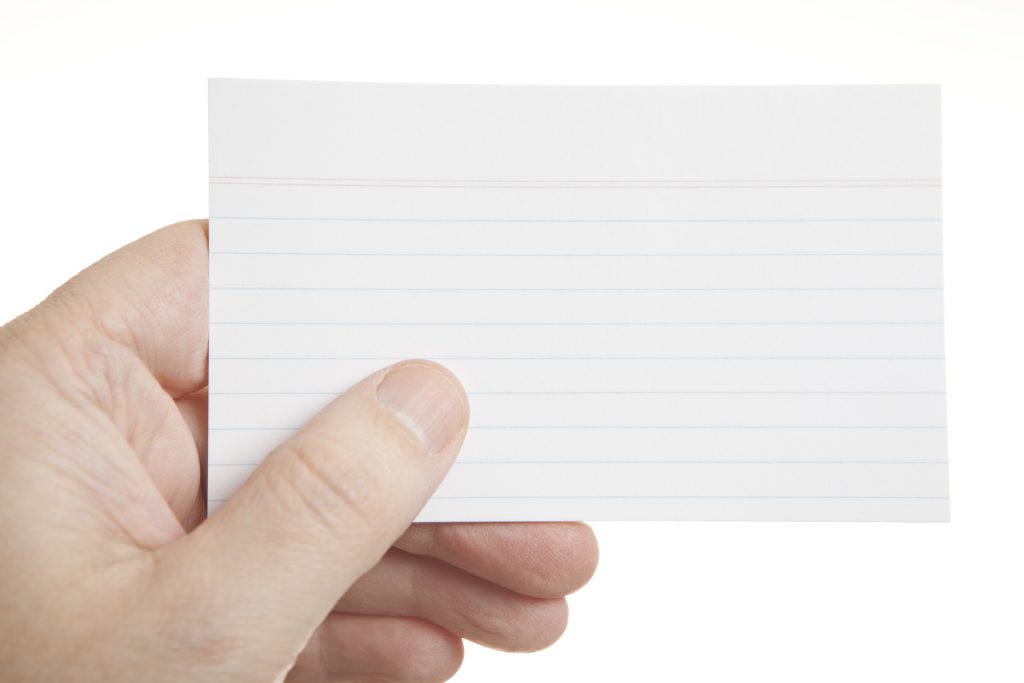
What are the three types of outlines?
Outlines are designed to evolve throughout your speech-preparation process, so in this section, we discuss the three types—a working outline, a full-sentence outline, and a speaking outline—and how you progress from each. Also, we discuss how using speaking-outline notecards help you as a speaker.
Working Outline
Use a working outline to develop your speech. This is the outline you use to lay out your speech’s basic structure, so it changes many times before it is complete. A great strategy to begin your working outline is to type out labels for each element. Later, fill in the content. The following are the outline labels that you must have:
Working Outline Labels
Your Name
Topic
General Purpose
Specific Purpose
Main Ideas
Introduction/Grabber
Thesis Statement
Preview
Transition
Main Point I
-
- supporting point
- supporting point
Transition
Main Point II
-
- supporting point
- supporting point
Transition
Main Point III
-
- supporting point
- supporting point
Transition
Conclusion
References
Also, a working outline allows you to work out your message’s kinks. For instance, let’s say you’ve made the claim that coal mining is a hazardous occupation, but you cannot find authoritative supporting evidence. Now, you must re-examine that main point to assess its validity. You might have to change that main point to be able to support it. If you do so, however, you must make sure that the new main point is a logical part of the thesis statement, the three main points, and the conclusion sequence. Don’t think of your working outline as a rough copy, but as a careful step in developing your message. It will take time to develop, but is well worth it as it lays your speech’s entire foundation. Here is a working outline example:
Name: Anomaly May McGillicuddy
Topic: Smart dust
General Purpose: To inform
Specific Purpose: To inform college science students about smart dust’s potential.
Main Ideas:
- Smart dust is an assembly of microcomputers.
- Smart dust can be used by the military—no. No—smart dust could be an enormous asset in covert military operations. (That’s better because it is clearer and precise).
- Smart dust could also have daily life applications.
Introduction: (Grabber) (fill in later)
Thesis Statement: Thus far, researchers hypothesize that smart dust could be used for everything from tracking hospital patients, to early natural-disaster warnings, to defending against bioterrorism.
Preview: Today, I’m going to explain what smart dust is and the various near-future smart dust applications. To help us understand the small of it all, I will first examine what smart dust is and how it works. I will then examine some smart-dust military applications. And I’ll end by discussing some smart dust-nonmilitary applications.
Transition: (fill in later)
Main Point I: Dr. Kris Pister, a robotics lab professor at the University of California, Berkeley, originally conceived the smart-dust idea in 1998 as part of a project funded by the Defense Advanced Research Projects Agency (DARPA).
- (supporting point)
- (supporting point)
Transition: (fill in later)
Main Point II: Because smart dust was originally conceptualized under a grant from DARPA, smart-dust military uses have been widely theorized and examined.
- (supporting point)
- (supporting point)
Transition: (fill in later)
Main Point III: According to the smart-dust project website, smart dust could quickly become a common part of our daily lives.
- (supporting point)
- (supporting point)
Transition: (fill in later)
Conclusion: (Bring your message full circle and create a psychologically satisfying closure.)
This working outline stage turns out to be a good place to go back and examine whether all the main points are directly related to the thesis statement and to each other. If so, your message has a strong potential for a unified focus. But if one main-point relationship is weak, this is the time to strengthen it. It will be more difficult to strengthen it later, for two reasons: first, the sheer amount of text on your pages will make the visual task more difficult, and second, it becomes increasingly difficult to change things in which you have invested much time and thought.
You can see that this working outline lays a strong foundation for the rest of your message. Its organization is visually apparent. Once you are confident in your basic message’s internal unity, begin filling in the supporting points in descending detail—that is, from the general main points, to the particular supporting points, and then to greater detail. The outline makes it visually apparent where information fits and allows you to assess your supporting points to be sure they’re authoritative and directly relevant to the main points they must support.
Now, let’s discuss transitions. Sometimes, and not surprisingly, transitions seem troublesome to write because we often omit them in informal conversations. Our conversation partners understand what we mean because of our gestures and vocal strategies. And even when we do include transitions, we don’t generally identify them as transitions. But in a speech, we must use effective transitions as a gateway from one main point to the next. The listener needs to know when a speaker is moving from one main point to the next.
In the next outline type—the full-sentence outline, take a look at the transitions and see how they make the listener aware of when you shift focus to the next main point.
Full-Sentence Outline
Write a full-sentence outline in full sentences only. There are several reasons why a full-sentence outline is important. First, this outline type includes a full plan of everything you intend to say to your audience so that you will not have to struggle with wordings or examples. Second, this outline type provides a clear idea of how much time it will take to present your speech. Third, a full-sentence outline showcases your ethical responsibility to your audience by detailing how fundamentally well-prepared you are. This is how a full-sentence outline looks:
Name: Anomaly May McGillicuddy
Topic: Smart dust
General Purpose: To inform
Specific Purpose: To inform college science students about smart-dust’s potential.
Main Ideas:
- Smart dust is an assembly of microcomputers.
- Smart dust could be an enormous asset in covert military operations.
- Smart dust could also have daily life applications.
Introduction/Grabber: In 2002, famed science-fiction writer Michael Crichton released his book Prey, which was about a swarm of nanomachines that were feeding off living tissue. The nanomachines were solar powered, self-sufficient, and intelligent. Most disturbingly, the nanomachines could work together as a swarm as it took over and killed its prey in its need for new resources. This nanotechnology-sophistication level is surprisingly more science fact than science fiction. In 2000, Kahn, Katz, and Pister, three electrical engineering and computer science professors at the University of California, Berkeley, hypothesized in the Journal of Communications and Networks that wireless networks of tiny microelectromechanical sensors, or MEMS; robots; or devices could detect phenomena including light, temperature, or vibration. By 2004, Fortune Magazine listed “smart dust” as the first in their “Top 10 Tech Trends to Bet On.”
Thesis Statement: Thus far, researchers hypothesized that smart dust could be used for everything from tracking hospital patients, to early natural-disaster warnings, to bioterrorism defense.
Preview: Today, I’m going to explain what smart dust is and the various near-future smart dust applications. To help us understand the small of it all, I’ll first discuss what smart dust is and how it works. I’ll then discuss some smart-dust military applications. And I’ll end by discussing some smart-dust nonmilitary applications.
Transition: To help us understand smart dust, I’ll begin by first examining what smart dust is.
Main Point I: Dr. Kris Pister, a robotics lab professor at the University of California, Berkeley, originally conceived the smart-dust idea in 1998 as part of a project funded by the Defense Advanced Research Projects Agency (DARPA).
- According to a 2001 article by Bret Warneke, Matt Last, Brian Liebowitz, and Kris Pister titled “Smart Dust: Communicating with a Cubic-Millimeter Computer” published in Computer, Pister’s goal was to build a device that contained a built-in sensor, a communication device, and a small computer that could be integrated into a one-cubic-millimeter package.
- For comparison purposes, Doug Steel, in a 2005 white paper titled “Smart Dust” written for C. T. Bauer College of Business at the University of Houston, noted that a single rice grain’s volume is five-cubic millimeters.
- Each individual dust piece, called a mote, would then have the ability to interact with other motes and supercomputers.
- As Steve Lohr wrote in the January 30, 2010, edition of the New York Times in an article titled “Smart Dust? Not Quite, But We’re Getting There,” smart dust could eventually consist of “Tiny digital sensors, strewn around the globe, gathering all sorts of information and communicating with powerful computer networks to monitor, measure, and understand the physical world in new ways.”
Transition: Now that we know what smart dust is, let’s switch gears and talk about some the smart-dust military applications.
Main Point II: Because smart dust was originally conceptualized under a grant from DARPA, smart-dust military uses have been widely theorized and examined.
- According to the smart dust website, smart dust could eventually be used for “battlefield surveillance, treaty monitoring, transportation monitoring, scud hunting” and other clear military applications.
- Probably, the number one smart-dust benefit in the military environment is its surveillance abilities.
- Major Scott Dickson, in a Blue Horizons paper written for the US Air Force Center for Strategy and Technology’s Air War College, sees smart dust as helping the military in battlespace awareness, homeland security, and identifying weapons of mass destruction.
- Furthermore, Major Dickson also believes it may be possible to create smart dust that has the ability to defeat communications-jamming equipment created by foreign governments, which could help the US military not only communicate among itself, but could also increase communications with civilians in military combat zones.
- Probably, the number one smart-dust benefit in the military environment is its surveillance abilities.
- According to a 2010 article written by Jessica Griggs in New Scientist, one of the first smart-dust benefits could be an early defense warning for space storms and other debris that could be catastrophic.
Transition: Now that we’ve explored some of smart-dust’s military benefits, let’s switch gears and see how smart dust may be able to impact our daily lives.
Main Point III: According to the smart-dust project website, smart dust could quickly become a common part of our daily lives.
- Everything from pasting smart-dust particles to our finger tips to create a virtual computer keyboard, to inventory control, to product quality control have been discussed as possible smart-dust applications.
- Steve Lohr, in his 2010 New York Times article, wrote, “The applications for sensor-based computing, experts say, include buildings that manage their own energy use, bridges that sense motion and metal fatigue to tell engineers they need repairs, cars that track traffic patterns and report potholes, and fruit and vegetable shipments that tell grocers when they ripen and begin to spoil.”
- Medically, according to the smart dust website, smart dust could help disabled individuals interface with computers.
- Theoretically, we could all be injected with smart dust, which detects adverse body changes instantly and relays information to our physicians.
- Smart dust could detect microscopic center-cell formations or alert us when we’ve been infected by a bacterium or virus, which could speed up treatment and prolong all our lives.
Transition: Today, we’ve explored what smart dust is, how the US military could use smart dust, and how smart dust could impact all our lives in the near future.
Conclusion: While smart dust is quickly transferring from science fiction to science fact, experts agree that smart dust’s full potential will probably not occur until 2025. Smart dust is definitely in our near future, but swarms of smart-dust eating people as was depicted in Michael Crichton’s 2002 novel, Prey, isn’t reality. However, as with any technological advance, there are definite ethical considerations and worries related to smart dust. Even Dr. Kris Pister’s smart-dust project website admits that as smart dust becomes more readily available, one of the trade-offs will be privacy. Pister responds to these critiques by saying, “As an engineer, or a scientist, or a hair stylist, everyone needs to evaluate what they do in terms of its positive and negative effect. If I thought that the negatives of working on this project were greater than or even comparable to the positives, I wouldn’t be working on it. As it turns out, I think that the potential benefits of this technology far outweigh the risks to personal privacy.”
References
Crichton, M. (2002). Prey. New York, NY: Harper Collins.
Dickson, S. (2007, April). Enabling battlespace persistent surveillance: the firm, function, and future of smart dust (Blue Horizons Paper, Center for Strategy and Technology, USAF Air War College). Retrieved from USAF Air War College website: http://www.au.af.mil/au/awc/awcgate/cst/bh_dickson.pdf
Griggs, J. (2010, February 6). Smart dust to provide solar early warning defense. New Scientist, 205(2746), 22.
Kahn, J. M., Katz, R. H., & Pister, K. S. J. (2000). Emerging challenges: Mobile networking for “smart dust.” Journal of Communications and Networks, 2, 188–196.
Lohr, S. (2010, January 30). Smart dust? Not quite, but we’re getting there. New York Times. Retrieved from http://www.nytimes.com
Pister, K., Kahn, J., & Boser, B. (n.d.). Smart dust: Autonomous sensing and communication at the cubic millimeter. Retrieved from http://robotics.eecs.berkeley.edu/~pister/SmartDust
Steel, D. (2005, March). Smart dust: UH ISRC technology briefing. Retrieved from http://www.uhisrc.com
Vogelstein, F., Boyle, M., Lewis, P., Kirkpatrick, D., Lashinsky, A.,…Chen, C. (2004, February 23). 10 tech trends to bet on. Fortune, 149(4), 74–88.
Warneke, B., Last, M., Liebowitz, B., & Pister, K. S. J. (2001). Smart dust: Communicating with a cubic millimeter computer. Computer, 31, 44–51.
When you prepare your full-sentence outline carefully, it may take as much as one- and one-half hours to complete the outline’s first part from your name at the top through the introduction. When you’ve completed that part, take a break and do something else. When you return to the outline, complete your draft in another one- and one-half hours. After that, you only need to do a detailed check for completeness, accuracy, relevance, balance, omitted words, and consistency. If you find errors, instead of being frustrated, be glad you can catch these errors before you stand up in front of your audience.
You will notice that the various speech parts, for instance, the transitions and main points, are labeled. There are compelling reasons for these labels. First, as you develop your message, you will sometimes find it necessary to go back and look at your wording in another part of the outline. Your labels help you find particular passages easily. Second, the labels work as a checklist so that you can make sure you’ve included everything you intended. Third, the labels helps you prepare your speaking outline.
You’ll also notice the full references at the outline’s end. They match the citations within the outline. Sometimes, while preparing a speech, a speaker finds it important to go back to an original source to be sure the message will be accurate. If you type in your references as you develop your speech rather than afterward, they will be a convenience to you if they are complete and accurate.
Don’t think of the references as busywork or drudgery. Although they’re more time consuming than text, they are good practice for the more advanced academic work you will do in the immediate future.
Speaking Outline and The Advantages of Using Presentation Notes
Your full-sentence outline prepares you to present a clear and well-organized message, but your speaking outline will include far less detail. Resist the temptation to use your full-sentence outline as your speaking outline. The temptation is real for at least two reasons. First, once you feel that you’ve carefully crafted every word sequence in your speech, you might not want to sacrifice quality when you shift to vocal presentation. Second, if you feel anxious about how well you will do in front of an audience, you may want to use your full-sentence outline as a safety net. In our experience, however, if you have your full-sentence outline with you, you will end up reading rather than speaking to your audience. Remember, do not read, instead, use carefully prepared notecards.
Your speech will probably have five main components: introduction, main point one, main point two, main point three, and the conclusion. Therefore, we recommend using five notecards—one for each component.
How will five notecards suffice in helping you produce a complete, rich delivery? Why can’t you use the full-sentence outline you labored so hard to write? First, your full-sentence outline will make it appear that you don’t know your speech’s content. Second, the temptation to read the speech directly from the full-sentence outline is nearly overwhelming; even if you resist this temptation, you will find yourself struggling to remember the words on the page rather than speaking extemporaneously. Third, paper is noisier and more awkward than cards. Fourth, it’s easier to lose your place using the full outline. Finally, cards just look better. Carefully prepared cards, together with practice, will help you more than you might think.
Use 4 × 6 cards. The smaller 3 × 5 cards are too small to provide space for visually organized notes. Number your cards, and write on one side only. Numbering is helpful if you happen to drop your cards, and writing on one side only means that while you are speaking, the audience is not distracted by your handwritten notes and reminders to yourself. Make sure that each card contains only key words and key phrases, but not full sentences.
Some speeches will include direct or extended quotations from expert sources. These quotations might be highly technical or difficult to memorize, but they must be presented correctly. This is a circumstance in which you include a sixth card in your notecard sequence. This is the one time you may read fully from a card. If your quotation is important, and the exact wording is crucial, your audience will understand that.
How are notecards sufficient? When they are carefully written and then you practice your speech using them, they will reveal that they work. If, during practice, you find that one card doesn’t work well enough, you can rewrite that card. Using carefully prepared, sparingly worded cards help you resist the temptation to rely on overhead transparencies or PowerPoint slides to get you through the presentation as well. Although they will never provide your exact full-sentence outline word sequence, they’ll keep you organized during your speech. The trick to selecting your cards’ phrases and quotations is to identify the labels that will trigger a recall sequence. For instance, if the phrase “more science fact” triggers connections between Crichton’s science fiction events in the novel Prey versus real science developments, that card phrase will support you through a fairly extended part of your introduction.
Ultimately, you must discover what works for you and then select those words that best jog your recall. Having identified what works, make a preliminary five-card set written on one side only, and practice with them. Revise and refine them as you would an outline.
The following is a hypothetical card set for the smart-dust speech:
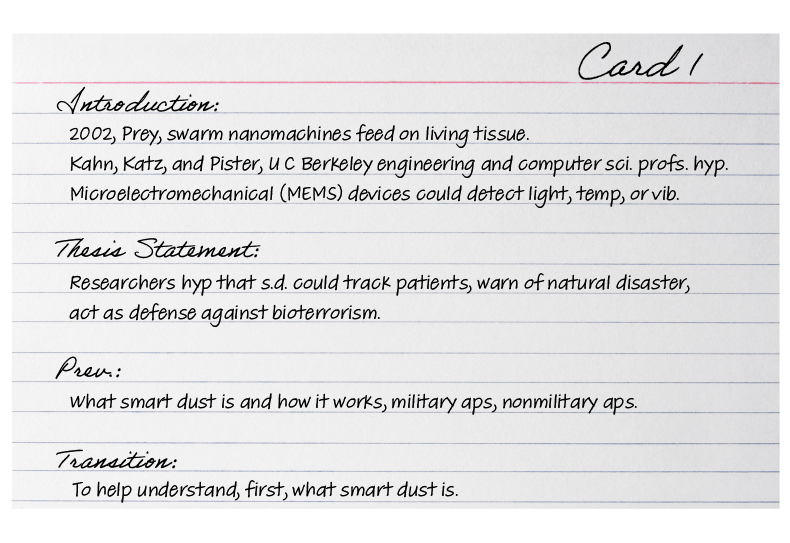
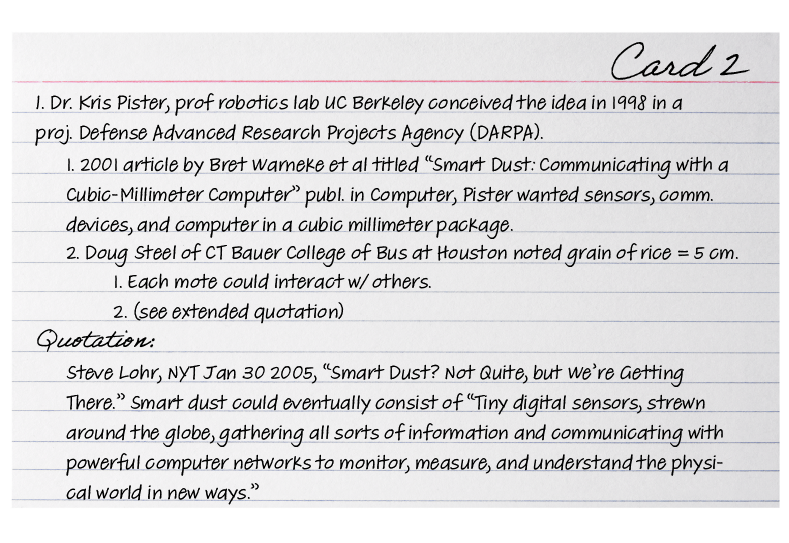
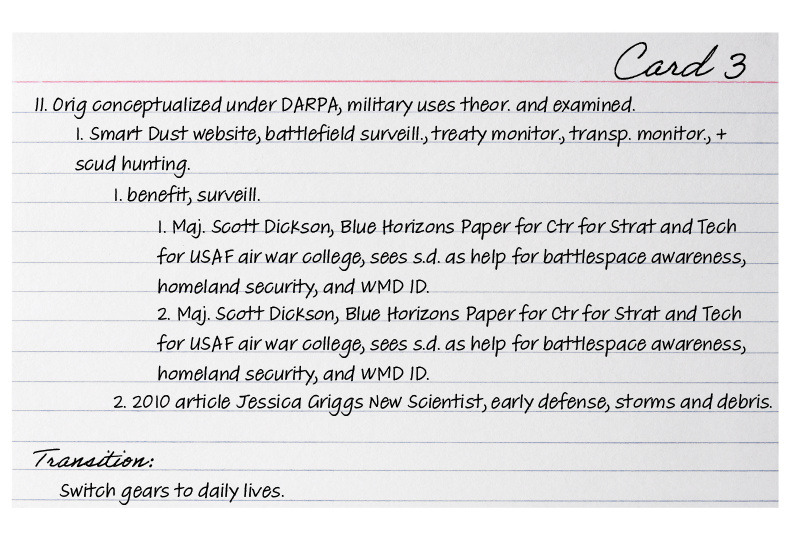
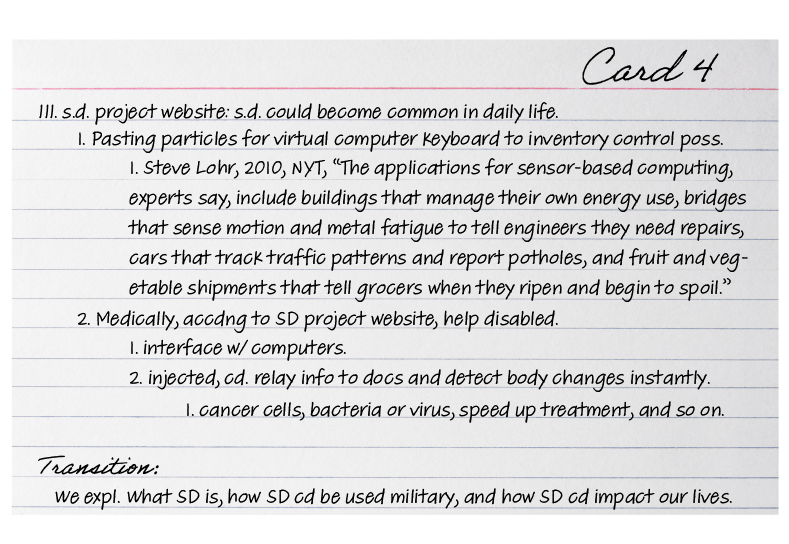
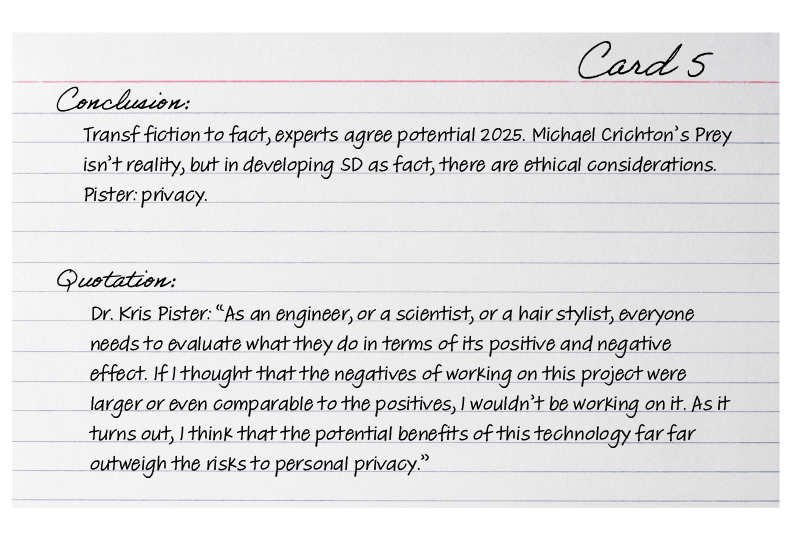
Creating and using a card set similar to the examples will help you condense and deliver an impressive set of specialized information. But, what if you lose your place during a speech? With a card set, it will take less time to find your place than with a full-sentence outline. You will not be rustling paper, and because your cards are written on one side only, you can keep them in order without flipping them back and forth to check both sides. What if you go blank? Take a few seconds to recall what you’ve said and how it leads to your next points. There may be several seconds of silence in the middle of your speech, and it may seem like minutes to you, but you can regain your footing most easily with a small well-prepared card set. Under no circumstances should you ever attempt to put your entire speech on cards in little tiny writing. You will end up reading word sequences to your audience instead of delivering a memorable message!
References
University of Minnesota. (2011). Stand up, Speak out: The Practice and Ethics of Public Speaking. University of Minnesota Libraries Publishing. https://open.lib.umn.edu/publicspeaking/. CC BY-SA 4.0.
Media References
Imageegaml. (2009, April 29). Hand Holding Blank Index Card stock photo [Image]. iStock Photo. https://www.istockphoto.com/photo/hand-holding-blank-index-card-gm115027533-9233893?utm_source=pixabay&utm_medium=affiliate&utm_campaign=SRP_image_sponsored&referrer_url=http%3A//pixabay.com/images/search/index%2520card/&utm_term=index%20card
Powell, B. (2021, July). Notecard 1 [Image]. Instructional Media Services, Salt Lake Community College.
Powell, B. (2021, July). Notecard 2 [Image]. Instructional Media Services, Salt Lake Community College.
Powell, B. (2021, July). Notecard 3 [Image]. Instructional Media Services, Salt Lake Community College.
Powell, B. (2021, July). Notecard 4 [Image]. Instructional Media Services, Salt Lake Community College.
Powell, B. (2021, July). Notecard 5 [Image]. Instructional Media Services, Salt Lake Community College.
Strategicgains. (2011, November 3). Using Outlines to Create a Presentation [Video]. YouTube. https://www.youtube.com/watch?v=_DeQRARzwmI
Tom706. (2007, April 4). parallelism [Image]. Flickr. https://www.flickr.com/photos/quelqu/446195756/
to develop the implications of : analyze logically

